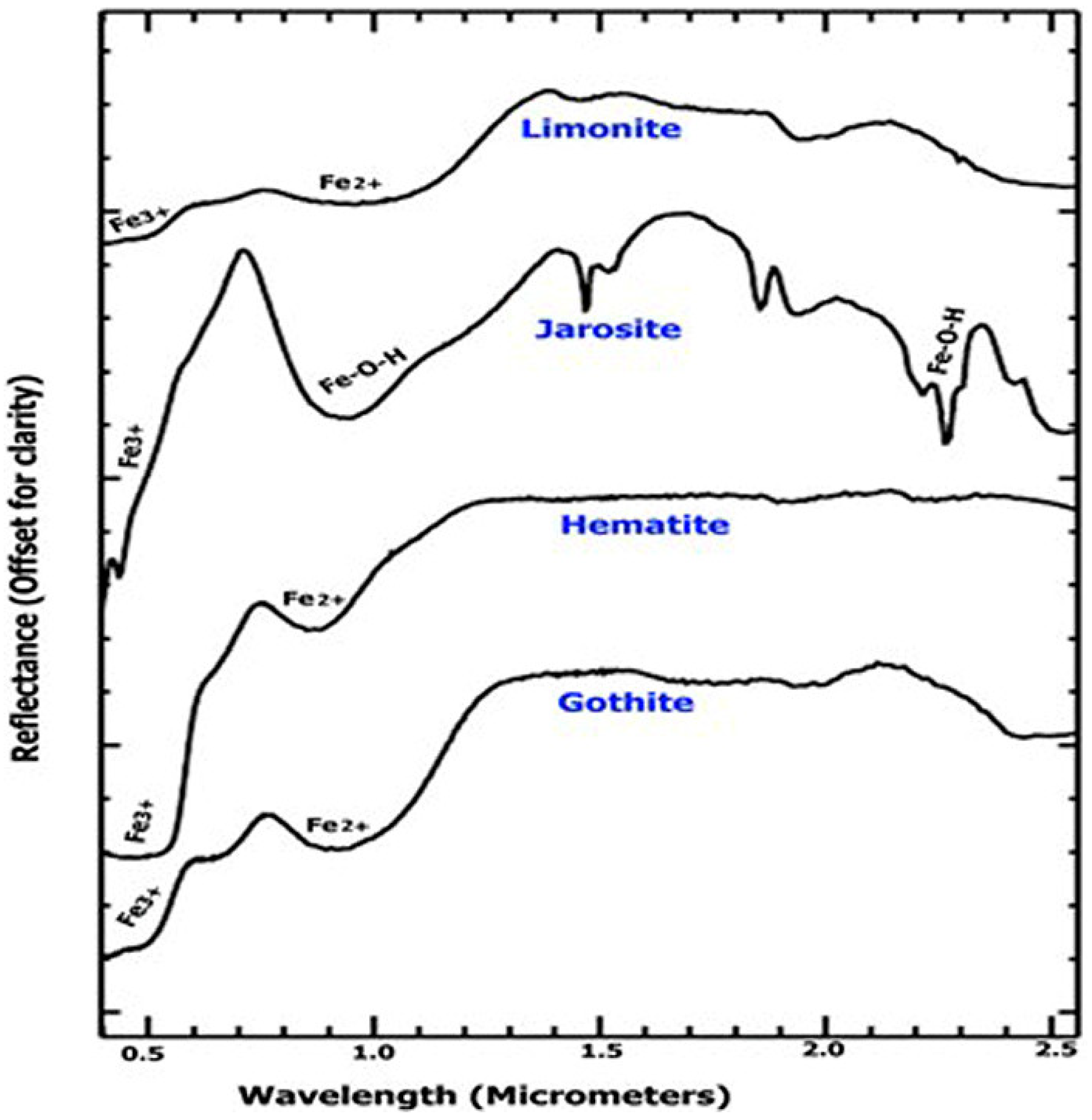High-Resolution UAV-Based Fuzzy Logic Mapping of Iron Oxide Alteration for Porphyry Copper Exploration: A Case Study from the Kyzylkiya Copper Prospect in Eastern Kazakhstan
Abstract
1. Introduction
2. Geology and Mineralization of the Study Area
3. Materials and Methods
3.1. Multispectral Arial Survey by UAV-Mounted DJI Phantom Sensor
- H—flight altitude (meters), sensor width—width of the camera sensor (millimeters),
- F—camera focal length (millimeters), image width—width of the image in pixels.
3.2. Processing of Multispectral Data
3.3. Spectral Analysis of UAV Data
3.4. Application of Fuzzy Logic
- -
- T is the threshold value,
- -
- μ is the average value,
- -
- σ is the standard deviation.
| Input Data | Threshold Value | Range of Determination | Membership Functions |
|---|---|---|---|
| NDVI | 0.4 | [0.4, 0] | [0.5, 1] |
| Band Ratio No. 1 | 1.073 | [1.073, 2.006] | [0.5, 1] |
| Band Ratio No. 1 | 1.136 | [1.136, 2.202] | [0.5, 1] |
- -
- T1 is the threshold value,
- -
- Tmax is the maximum value of the index.
- -
- μA(x) and μB(x) are the membership functions for two input datasets,
- -
- μA ∩ B(x) is the result of applying the “and” operator.
- -
- Z is the crisp value (in our case, the probability of mineralization),
- -
- μ(z) is the membership function describing the degree of probability for each value of z,
- -
- the numerator is the integral of the weighted fuzzy values,
- -
- the denominator is the integral of the membership function.
4. Results and Data Analysis
5. Discussion
6. Conclusions
Author Contributions
Funding
Data Availability Statement
Acknowledgments
Conflicts of Interest
References
- Alarifi, S.S.; Abdelkareem, M.; Abdalla, F.; Abdelsadek, I.S.; Gahlan, H.; Al-Saleh, A.M.; Alotaibi, M. Fusion of Multispectral Remote-Sensing Data through GIS-Based Overlay Method for Revealing Potential Areas of Hydrothermal Mineral Resources. Minerals 2022, 12, 1577. [Google Scholar] [CrossRef]
- Rahmani, N.R.; Ahmadi, H.; Rahimy, F.; Yousufi, A. Automated detection of granitic complexes in NW Parwan, NE Afghanistan using Sentinel-2B/MSI and ASTER data. Discov. Geosci. 2024, 2, 86. [Google Scholar] [CrossRef]
- Jain, R.; Bhu, H.; Pandey, A.K.; Pour, A.B. Base-metal exploration by using remote sensing, geological, geophysical, and geochemical datasets with clues from ancient mining: A comprehensive review on Aravalli-Delhi Fold Belt, Rajasthan, India. Adv. Space Res. 2025, 75, 277–315. [Google Scholar] [CrossRef]
- Fallah, M.; Jamali, H.; Alaminia, Z.; Pour, A.B. ASTER remote sensing data for detecting porphyry copper type alteration patterns in West Zafarghand Cu±Mo deposit, Iran. Int. J. Image Data Fusion 2024, 1–31. [Google Scholar] [CrossRef]
- Ousmanou, S.; Martial, F.E.; Jules, T.K.; Ludovic, A.M.; Agnès Blandine, K.T.; Sufinatu, A.; Mohamed, R.; Maurice, K. Mapping and discrimination of the mineralization potential in granitoids from Banyo area (Adamawa, Cameroon), using Landsat 9 OLI, ASTER images and field observations. Geosyst. Geoenviron. 2024, 3, 100239. [Google Scholar] [CrossRef]
- Traore, M.; Takodjou Wambo, J.D.; Ndepete, C.P.; Tekin, S.; Pour, A.B.; Muslim, A.M. Lithological and alteration mineral mapping for alluvial gold exploration in the south east of Birao area, Central African Republic using Landsat-8 Operational Land Imager (OLI) data. J. Afr. Earth Sci. 2020, 170, 103933. [Google Scholar] [CrossRef]
- Saremi, M.; Hoseinzade, Z.; Mirzabozorg, S.A.A.S.; Pour, A.B.; Zoheir, B.; Almasi, A. Integrated remote sensing and geochemical studies for enhanced prospectivity mapping of porphyry copper deposits: A case study from the Pariz district, Urmia-Dokhtar metallogenic belt, southern Iran. Remote Sens. Appl. Soc. Environ. 2024, 36, 101343. [Google Scholar] [CrossRef]
- Cudahy, T.; Caccetta, M.; Thomas, M.; Hewson, R.; Abrams, M.; Kato, M.; Kashimura, O.; Ninomiya, Y.; Yamaguchi, Y.; Collings, S.; et al. Satellite-derived mineral mapping and monitoring of weathering, deposition and erosion. Sci. Rep. 2016, 6, 23702. [Google Scholar] [CrossRef]
- Kruse, F.A.; Boardman, J.W.; Huntington, J.F. Comparison of airborne hyperspectral data and eo-1 hyperion for mineral mapping. IEEE Trans. Geosci. Remote Sens. 2003, 41, 1388–1400. [Google Scholar] [CrossRef]
- van der Meer, F.D.; van der Werff, H.M.A.; van Ruitenbeek, F.J.A. Potential of ESA’s Sentinel-2 for geological applications. Remote Sens. Environ. 2014, 148, 124–133. [Google Scholar] [CrossRef]
- Groves, D.I.; Bierlein, F.P.; Meinert, L.D.; Hitzman, M.W. Iron Oxide Copper-Gold (IOCG) Deposits through Earth History: Implications for Origin, Lithospheric Setting, and Distinction from Other Epigenetic Iron Oxide Deposits. Econ. Geol. 2010, 105, 641–654. [Google Scholar] [CrossRef]
- Sun, X.-L.; Wang, Y.; Xiong, H.-Q.; Wu, F.; Lv, T.-X.; Fang, Y.-C.; Xiang, H. The Role of Surface Functional Groups of Iron Oxide, Organic Matter, and Clay Mineral Complexes in Sediments on the Adsorption of Copper Ions. Sustainability 2023, 15, 6711. [Google Scholar] [CrossRef]
- Huang, X.-W.; Boutroy, É.; Makvandi, S.; Beaudoin, G.; Corriveau, L.; De Toni, A.F. Trace element composition of iron oxides from IOCG and IOA deposits: Relationship to hydrothermal alteration and deposit subtypes. Miner. Depos. 2019, 54, 525–552. [Google Scholar] [CrossRef]
- Orynbassarova, E.O.; Adebiyet, B.; Iliuf, F.A.; Sydyk, N.K. Analysis of mineral indices from remote sensing: A case-study of the Tokrau river. Eurasian Min. 2024, 1, 71–76. [Google Scholar] [CrossRef]
- Cardoso-Fernandes, J.; Teodoro, A.C.; Lima, A.; Perrotta, M.; Roda-Robles, E. Detecting Lithium (Li) mineralizations from space: Current research and future perspectives. Appl. Sci. 2020, 10, 1785. [Google Scholar] [CrossRef]
- Chen, Y.; Wang, Y.; Zhang, F.; Dong, Y.; Song, Z.; Liu, G. Remote Sensing for Lithology Mapping in Vegetation-Covered Regions: Methods, Challenges, and Opportunities. Minerals 2023, 13, 1153. [Google Scholar] [CrossRef]
- Gürsoy, Ö.; Kaya, Ş.; Çakir, Z.; Tatar, O.; Canbaz, O. Determining lateral offsets of rocks along the eastern part of the North Anatolian Fault Zone (Turkey) using spectral classification of satellite images and field measurements. Geomat. Nat. Hazards Risk 2017, 8, 1276–1288. [Google Scholar] [CrossRef]
- Rajan Girija, R.; Mayappan, S. Mapping of mineral resources and lithological units: A review of remote sensing techniques. Int. J. Image Data Fusion 2019, 10, 79–106. [Google Scholar] [CrossRef]
- Rowan, L.C.; Mars, J.C.; Simpson, C.J. Lithologic mapping of the Mordor, NT, Australia ultramafic complex by using the Advanced Spaceborne Thermal Emission and Reflection Radiometer (ASTER). Remote Sens. Environ. 2005, 99, 105–126. [Google Scholar] [CrossRef]
- Seifi, A.; Esmaeily, A.; Mokhtari, Z. A new hybrid method for epithermal gold exploration using multi-sensor satellite data in Sistan and Baluchestan Province (Iran). Ore Geol. Rev. 2021, 138, 104357. [Google Scholar] [CrossRef]
- Abay, H.H.; Legesse, D.; Venkata Suryabhagavan, K.; Atnafu, B. Mapping of ferric (Fe3+) and ferrous (Fe2+) iron oxides distribution using ASTER and Landsat 8 OLI data, in Negash Lateritic iron deposit, Northern Ethiopia. Geol. Ecol. Landsc. 2024, 8, 223–240. [Google Scholar] [CrossRef]
- Kumar, C.; Chatterjee, S.; Oommen, T.; Guha, A. Automated lithological mapping by integrating spectral enhancement techniques and machine learning algorithms using AVIRIS-NG hyperspectral data in Gold-bearing granite-greenstone rocks in Hutti, India. Int. J. Appl. Earth Obs. Geoinf. 2020, 86, 102006. [Google Scholar] [CrossRef]
- Park, S.; Choi, Y. Applications of Unmanned Aerial Vehicles in Mining from Exploration to Reclamation: A Review. Minerals 2020, 10, 663. [Google Scholar] [CrossRef]
- Choi, Y. Applications of Unmanned Aerial Vehicle and Artificial Intelligence Technologies in Mining from Exploration to Reclamation. Minerals 2023, 13, 382. [Google Scholar] [CrossRef]
- Honarmand, M.; Shahriari, H. Geological Mapping Using Drone-Based Photogrammetry: An Application for Exploration of Vein-Type Cu Mineralization. Minerals 2021, 11, 585. [Google Scholar] [CrossRef]
- Shahsavani, H.; Smith, R.S. Aeromagnetic gradiometry with UAV, a case study on small iron ore deposit. Drone Syst. Appl. 2024, 12, 1–9. [Google Scholar] [CrossRef]
- Uniyal, A.; Gond, A.; Tiwari, T.; Pandit, S.; Gupta, C.; Saikhom, V.; Dinkar, G. UAV/Drone-Based Identification of Geomorphic and Structural Anomalies as Probable Indicators of Economic Mineral Deposits in Girar Area of Lalitpur District, U.P., (India). J. Indian Soc. Remote Sens. 2022, 50, 937–947. [Google Scholar] [CrossRef]
- Sang, X.; Xue, L.; Ran, X.; Li, X.; Liu, J.; Liu, Z. Intelligent High-Resolution Geological Mapping Based on SLIC-CNN. ISPRS Int. J. Geo-Inf. 2020, 9, 99. [Google Scholar] [CrossRef]
- Abubakar, F.; Alao, J.O.; Ogah, A.J.; Ayuba, R.; Lekdukun, M.O.; Baba, Y.; Sadiq, F.K.; Samson, E.E.; Aliyu, A. Evaluation of gold mineralisation potential using AHP systems and weighted overlay analysis. Sci. Rep. 2024, 14, 21263. [Google Scholar] [CrossRef]
- Biswas, A. Methods and applications in petroleum and mineral exploration and engineering geology (1st edn). J. Earth Syst. Sci. 2021, 130, 231. [Google Scholar] [CrossRef]
- Grunsky, E.C.; Caritat, P. de State-of-the-art analysis of geochemical data for mineral exploration. Geochem. Explor. Environ. Anal. 2020, 20, 217–232. [Google Scholar] [CrossRef]
- Liu, Y.; Carranza, E.J.M.; Xia, Q. Developments in Quantitative Assessment and Modeling of Mineral Resource Potential: An Overview. Nat. Resour. Res. 2022, 31, 1825–1840. [Google Scholar] [CrossRef]
- Moon, W.M. Integration and fusion of geological exploration data: A theoretical review of fuzzy logic approach. Geosci. J. 1998, 2, 175–183. [Google Scholar] [CrossRef]
- Pazand, K.; Hezarkhani, A. Porphyry Cu potential area selection using the combine AHP-TOPSIS methods: A case study in Siahrud area (NW, Iran). Earth Sci. Inform. 2015, 8, 207–220. [Google Scholar] [CrossRef]
- Peixoto, S.F.; Coimbra Horbe, A.M.; Soares, T.M.; Freitas, C.A.; Dalat de Sousa, E.M.; Herrera de Figueiredo Iza, E.R. Boolean and fuzzy logic operators and multivariate linear regression applied to airborne gamma-ray spectrometry data for regolith mapping in granite-greenstone terrain in Midwest Brazil. J. S. Am. Earth Sci. 2021, 112, 103562. [Google Scholar] [CrossRef]
- Khosravi, V.; Shirazi, A.; Shirazy, A.; Hezarkhani, A.; Pour, A.B. Hybrid Fuzzy-Analytic Hierarchy Process (AHP) Model for Porphyry Copper Prospecting in Simorgh Area, Eastern Lut Block of Iran. Mining 2021, 2, 1–12. [Google Scholar] [CrossRef]
- Ousmanou, S.; Fodoue, Y.; Wadjou, J.W.; Kepnamou, A.D.; Fozing, E.M.; Kwékam, M.; Ikfi, M. Fuzzy-logic technique for gold mineralization prospecting using Landsat 9 OLI processing and fieldwork data in the Bibemi goldfield, north Cameroon. Heliyon 2024, 10, e23334. [Google Scholar] [CrossRef]
- Shirazi, A.; Hezarkhani, A.; Beiranvand Pour, A.; Shirazy, A.; Hashim, M. Neuro-Fuzzy-AHP (NFAHP) Technique for Copper Exploration Using Advanced Spaceborne Thermal Emission and Reflection Radiometer (ASTER) and Geological Datasets in the Sahlabad Mining Area, East Iran. Remote Sens. 2022, 14, 5562. [Google Scholar] [CrossRef]
- Alpysbay, M.A.; Orynbassarova, E.O.; Sydyk, N.K.; Adebiyet, B.; Kamza, A.T. Mining mapping and exploration using remote sensing data in Kazakhstan: A review. Eng. J. Satbayev Univ. 2024, 146, 37–46. [Google Scholar] [CrossRef]
- Zvezdov, V.S.; Migachev, I.F.; Girfanov, M.M. Porphyry copper deposits of the CIS and the models of their formation. Ore Geol. Rev. 1993, 7, 511–549. [Google Scholar] [CrossRef]
- Li, C.; Shen, P.; Pan, H.; Cao, C.; Seitmuratova, E. Geology and ore-forming fluid evolution of the Aktogai giant porphyry Cu deposit, Kazakhstan. J. Asian Earth Sci. 2018, 165, 192–209. [Google Scholar] [CrossRef]
- Chen, X.; Seitmuratova, E.; Wang, Z.; Chen, Z.; Han, S.; Li, Y.; Yang, Y.; Ye, B.; Shi, W. SHRIMP U–Pb and Ar–Ar geochronology of major porphyry and skarn Cu deposits in the Balkhash Metallogenic Belt, Central Asia, and geological implications. J. Asian Earth Sci. 2014, 79, 723–740. [Google Scholar] [CrossRef]
- Cao, M.; Li, G.; Qin, K.; Seitmuratova, E.Y.; Liu, Y. Major and Trace Element Characteristics of Apatites in Granitoids from Central Kazakhstan: Implications for Petrogenesis and Mineralization. Resour. Geol. 2012, 62, 63–83. [Google Scholar] [CrossRef]
- Shen, P.; Pan, H.; Hattori, K.; Cooke, D.R.; Seitmuratova, E. Large Paleozoic and Mesozoic porphyry deposits in the Central Asian Orogenic Belt: Geodynamic settings, magmatic sources, and genetic models. Gondwana Res. 2018, 58, 161–194. [Google Scholar] [CrossRef]
- Li, C.; Shen, P.; Pan, H. Mineralogy of the Aktogai giant porphyry Cu deposit in Kazakhstan: Insights into the fluid composition and oxygen fugacity evolution. Ore Geol. Rev. 2018, 95, 899–916. [Google Scholar] [CrossRef]
- Cao, M.-J.; Li, G.-M.; Qin, K.-Z.; Evans, N.J.; Seitmuratova, E.Y. Assessing the magmatic affinity and petrogenesis of granitoids at the giant Aktogai porphyry Cu deposit, Central Kazakhstan. Am. J. Sci. 2016, 316, 614–668. [Google Scholar] [CrossRef]
- Li, C.; Shen, P.; Zhao, Y.; Li, P.; Zhang, L.; Pan, H. Mineral chemistry of chlorite in different geologic environments and its implications for porphyry Cu ± Au ± Mo deposits. Ore Geol. Rev. 2022, 149, 105112. [Google Scholar] [CrossRef]
- Gallardo-Salazar, J.L.; Pompa-García, M. Detecting Individual Tree Attributes and Multispectral Indices Using Unmanned Aerial Vehicles: Applications in a Pine Clonal Orchard. Remote Sens. 2020, 12, 4144. [Google Scholar] [CrossRef]
- Akhmetov, R.; Makhmetova, G.; Orynbassarova, E.; Baltiyeva, A.; Togaibekov, A.; Roberts, K.; Yerzhankyzy, A. The study of kinematic gnss surveying for BIM georeferencing. Int. Arch. Photogramm. Remote Sens. Spat. Inf. Sci. 2022, 46, 7–14. [Google Scholar] [CrossRef]
- Van Canh, L.; Xuan Cuong, C.; Quoc Long, N.; Thi Thu Ha, L.; Trung Anh, T.; Bui, X.-N. Experimental Investigation on the Performance of DJI Phantom 4 RTK in the PPK Mode for 3D Mapping Open-Pit Mines. Inżynieria Miner. 2020, 1, 65–74. [Google Scholar] [CrossRef]
- Kovanič, Ľ.; Topitzer, B.; Peťovský, P.; Blišťan, P.; Gergeľová, M.B.; Blišťanová, M. Review of Photogrammetric and Lidar Applications of UAV. Appl. Sci. 2023, 13, 6732. [Google Scholar] [CrossRef]
- Fazeli, H.; Samadzadegan, F.; Dadrasjavan, F. Evaluating the potential of RTK-UAV for automatic point cloud generation in 3D rapid mapping. Int. Arch. Photogramm. Remote Sens. Spat. Inf. Sci. 2016, 41, 221–226. [Google Scholar] [CrossRef]
- Martínez-Carricondo, P.; Agüera-Vega, F.; Carvajal-Ramírez, F. Accuracy assessment of RTK/PPK UAV-photogrammetry projects using differential corrections from multiple GNSS fixed base stations. Geocarto Int. 2023, 38, 2197507. [Google Scholar] [CrossRef]
- Shylesh, D.; Manikandan, N.; Sivasankar, S.; Surendran, D.; Jaganathan, R.; Mohan, G. Influence of quantity, quality, horizontal and vertical distribution of ground control points on the positional accuracy of UAV survey. Appl. Geomat. 2023, 15, 897–917. [Google Scholar] [CrossRef]
- Park, J.W.; Yeom, D.J. Method for establishing ground control points to realize UAV-based precision digital maps of earthwork sites. J. Asian Archit. Build. Eng. 2022, 21, 110–119. [Google Scholar] [CrossRef]
- Olsson, P.-O.; Vivekar, A.; Adler, K.; Garcia Millan, V.E.; Koc, A.; Alamrani, M.; Eklundh, L. Radiometric Correction of Multispectral UAS Images: Evaluating the Accuracy of the Parrot Sequoia Camera and Sunshine Sensor. Remote Sens. 2021, 13, 577. [Google Scholar] [CrossRef]
- Uysal, M.; Toprak, A.S.; Polat, N. DEM generation with UAV Photogrammetry and accuracy analysis in Sahitler hill. Measurement 2015, 73, 539–543. [Google Scholar] [CrossRef]
- Abdelmalik, K.W.; Abd-Allah, A.M.A. Integration of remote sensing technique and field data in geologic mapping of an ophiolitic suture zone in western Arabian Shield. J. Afr. Earth Sci. 2018, 146, 180–190. [Google Scholar] [CrossRef]
- Clark, R.N. Spectroscopy of Rocks Andminerals, and Principles of Spectrocopy; USGS Spectroscopy Lab: Denver, CO, USA, 1999. [Google Scholar]
- Yang, C.; Jia, H.; Dong, L.; Zhao, H.; Zhao, M. Selection of Landsat-8 Operational Land Imager (OLI) Optimal Band Combinations for Mapping Alteration Zones. Remote Sens. 2024, 16, 392. [Google Scholar] [CrossRef]
- Ahmadi, H.; Uygucgil, H. Targeting iron prospective within the Kabul Block (SE Afghanistan) via hydrothermal alteration mapping using remote sensing techniques. Arab. J. Geosci. 2021, 14, 183. [Google Scholar] [CrossRef]
- Sabins, F.F. Remote sensing for mineral exploration. Ore Geol. Rev. 1999, 14, 157–183. [Google Scholar] [CrossRef]
- Chávez, W.X. Supergene Oxidation of Copper Deposits: Zoning and Distribution of Copper Oxide Minerals. SEG Discov. 2000, 41, 1–21. [Google Scholar] [CrossRef]
- Heinrich, C.A. The Chain of Processes Forming Porphyry Copper Deposits—An Invited Paper. Econ. Geol. 2024, 119, 741–769. [Google Scholar] [CrossRef]
- Yang, Y.; Meng, Z.; Zu, J.; Cai, W.; Wang, J.; Su, H.; Yang, J. Fine-Scale Mangrove Species Classification Based on UAV Multispectral and Hyperspectral Remote Sensing Using Machine Learning. Remote Sens. 2024, 16, 3093. [Google Scholar] [CrossRef]
- Zeng, C.; King, D.J.; Richardson, M.; Shan, B. Fusion of Multispectral Imagery and Spectrometer Data in UAV Remote Sensing. Remote Sens. 2017, 9, 696. [Google Scholar] [CrossRef]
- Deshpande, S.; Subeesh, A.; Saini, A. Analysis of Most Significant Bands and Band Ratios for Discrimination of Hydrothermal Alteration Minerals. In Proceedings of the 2019 10th Workshop on Hyperspectral Imaging and Signal Processing: Evolution in Remote Sensing (WHISPERS), Amsterdam, The Netherlands, 24–26 September 2019; IEEE: Piscataway, NJ, USA, 2019; pp. 1–5. [Google Scholar]
- Jackisch, R.; Lorenz, S.; Zimmermann, R.; Möckel, R.; Gloaguen, R. Drone-Borne Hyperspectral Monitoring of Acid Mine Drainage: An Example from the Sokolov Lignite District. Remote Sens. 2018, 10, 385. [Google Scholar] [CrossRef]
- Wan, Y.; Fan, Y.; Jin, M. Application of hyperspectral remote sensing for supplementary investigation of polymetallic deposits in Huaniushan ore region, northwestern China. Sci. Rep. 2021, 11, 440. [Google Scholar] [CrossRef]
- Sekandari, M.; Beiranvand Pour, A. Fuzzy Logic Modeling for Integrating the Thematic Layers Derived from Remote Sensing Imagery: A Mineral Exploration Technique. In Proceedings of the 2nd International Electronic Conference on Mineral Science, Online, 1–15 March 2021; MDPI: Basel, Switzerland, 2021; p. 8. [Google Scholar]
- Ekaputri, R.Z.; Hidayat, T.; Surtikanti, H.K.; Surakusumah, W. Modeling vegetation density with remote sensing, normalized difference vegetation index and biodiversity plants in watershed area. Glob. J. Environ. Sci. Manag. 2024, 10, 4. [Google Scholar] [CrossRef]
- Huang, S.; Tang, L.; Hupy, J.P.; Wang, Y.; Shao, G. A commentary review on the use of normalized difference vegetation index (NDVI) in the era of popular remote sensing. J. For. Res. 2021, 32, 2719. [Google Scholar] [CrossRef]
- Orynbassarova, E.; Ahmadi, H.; Adebiyet, B.; Bekbotayeva, A.; Abdullayeva, T.; Beiranvand Pour, A.; Ilyassova, A.; Serikbayeva, E.; Talgarbayeva, D.; Bermukhanova, A. Mapping Alteration Minerals Associated with Aktogay Porphyry Copper Mineralization in Eastern Kazakhstan Using Landsat-8 and ASTER Satellite Sensors. Minerals 2025, 15, 277. [Google Scholar] [CrossRef]
- Melin, P.; Castillo, O.; Kacprzyk, J.; Reformat, M.; Melek, W. Fuzzy Logic in Intelligent System Design; Advances in Intelligent Systems and Computing; Springer International Publishing: Cham, Switzerland, 2017; Volume 648, ISBN 978-3-319-67136-9. [Google Scholar]
- Lachaud, A.; Adam, M.; Mišković, I. Comparative Study of Random Forest and Support Vector Machine Algorithms in Mineral Prospectivity Mapping with Limited Training Data. Minerals 2023, 13, 1073. [Google Scholar] [CrossRef]
- Ghezelbash, R.; Maghsoudi, A.; Bigdeli, A.; Carranza, E.J.M. Regional-Scale Mineral Prospectivity Mapping: Support Vector Machines and an Improved Data-Driven Multi-criteria Decision-Making Technique. Nat. Resour. Res. 2021, 30, 1977–2005. [Google Scholar] [CrossRef]
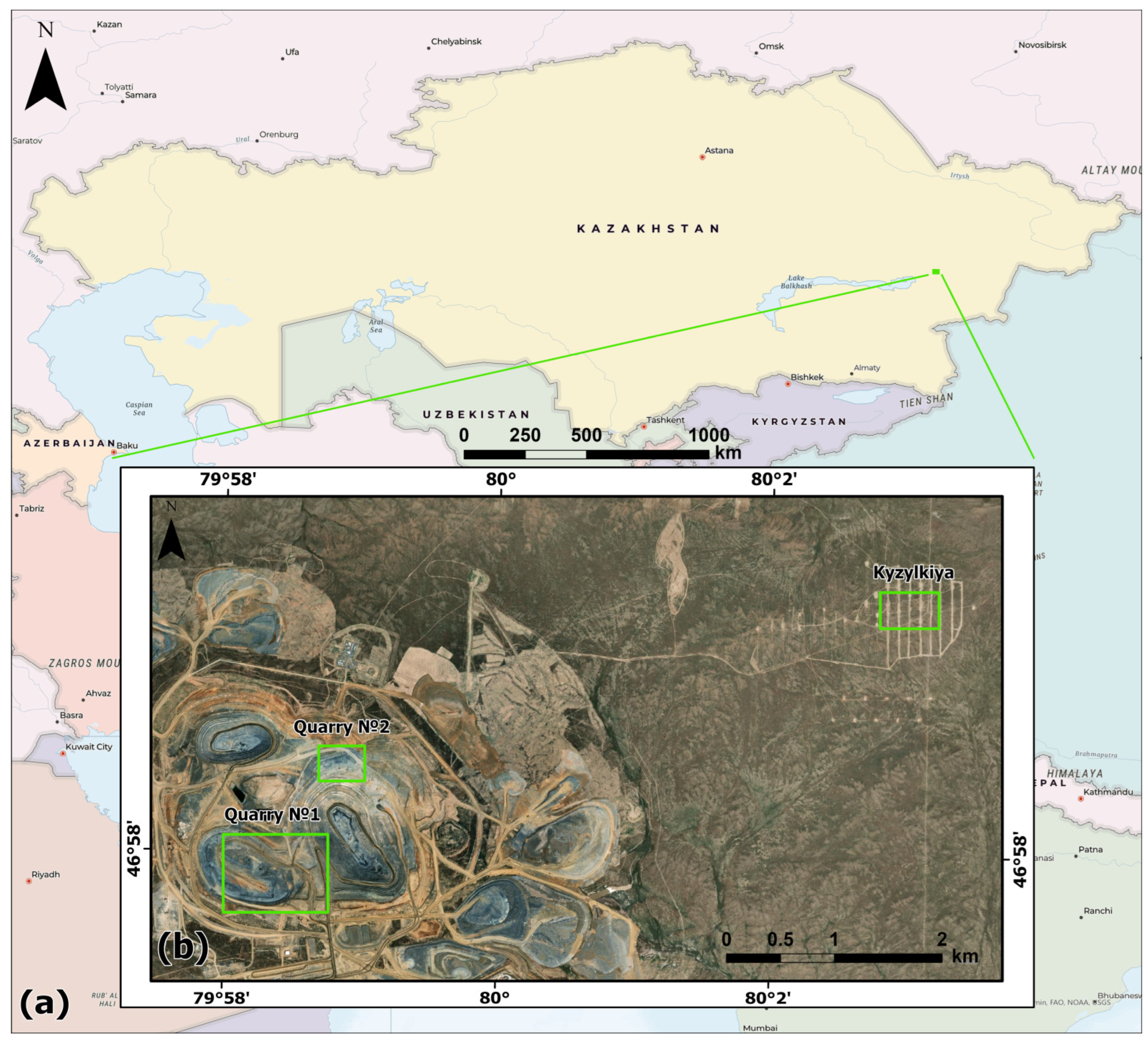
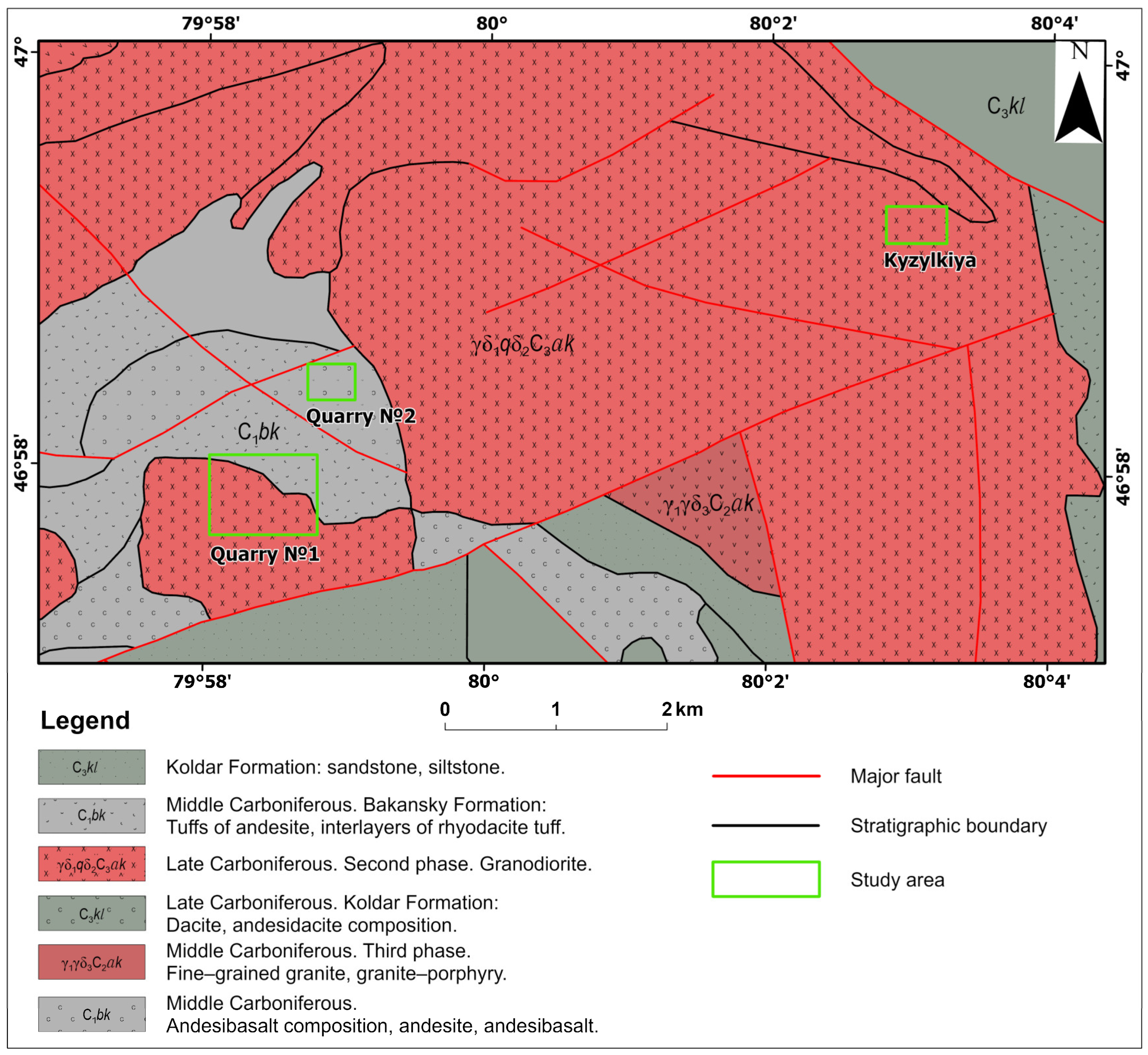
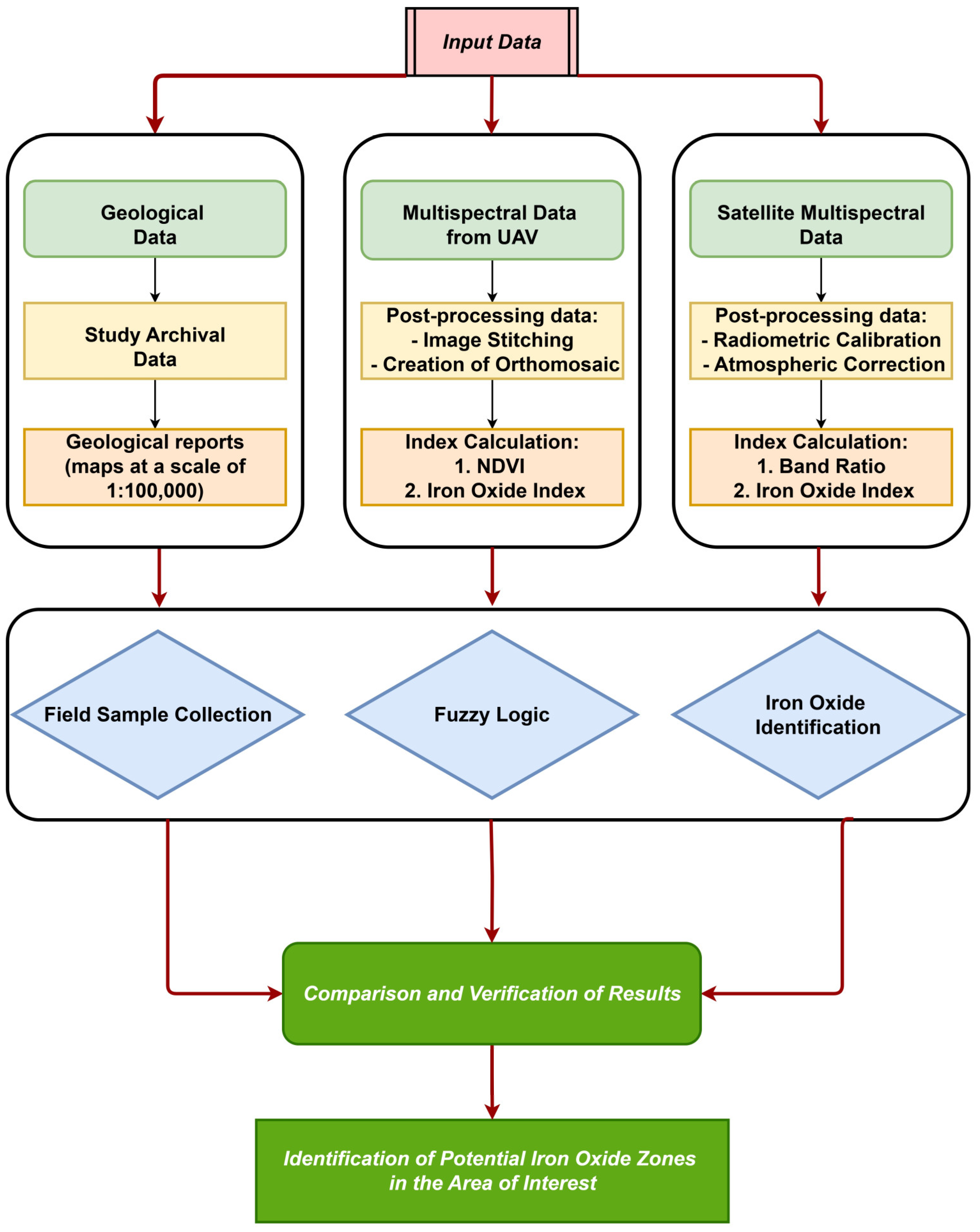
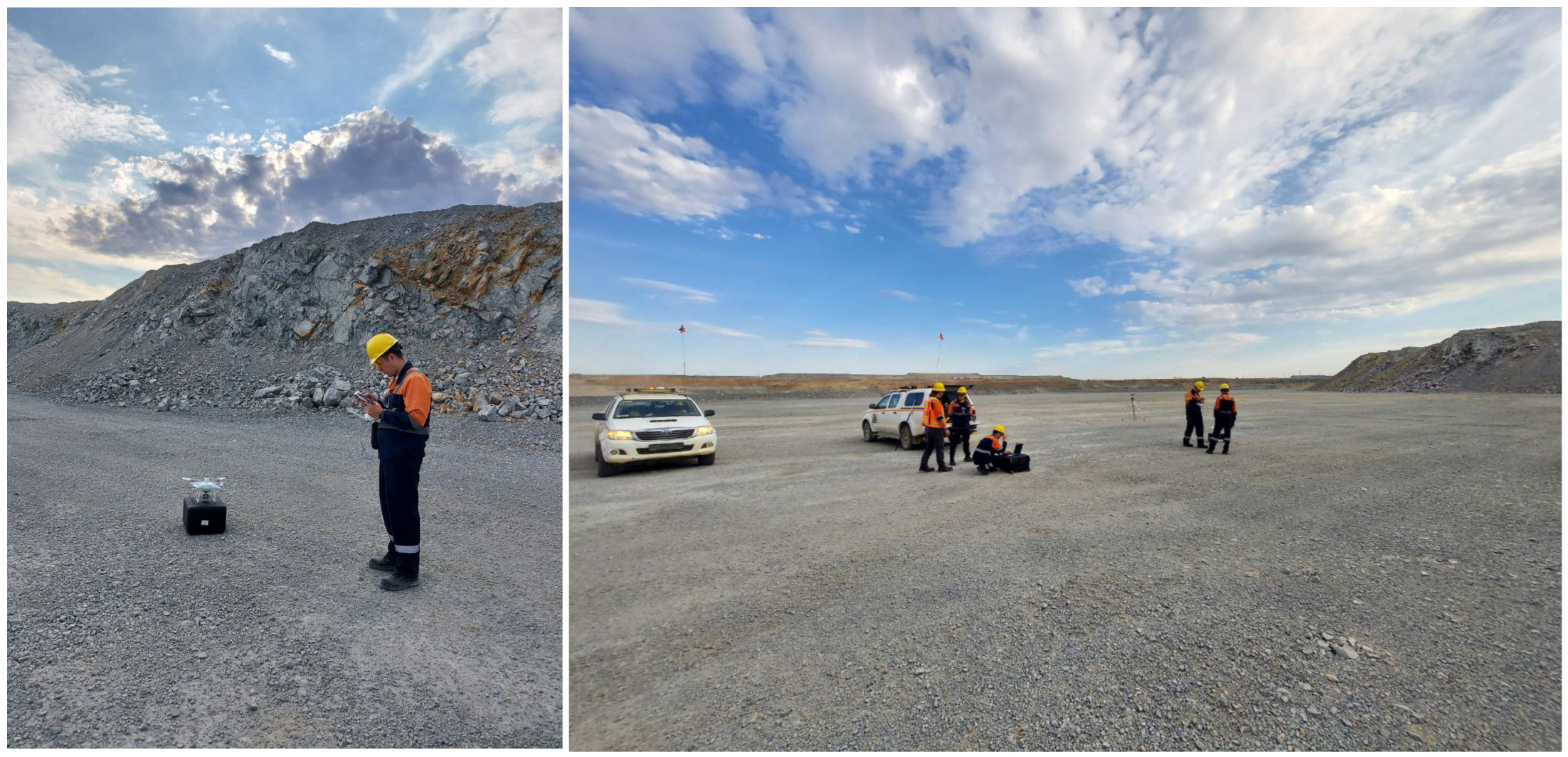
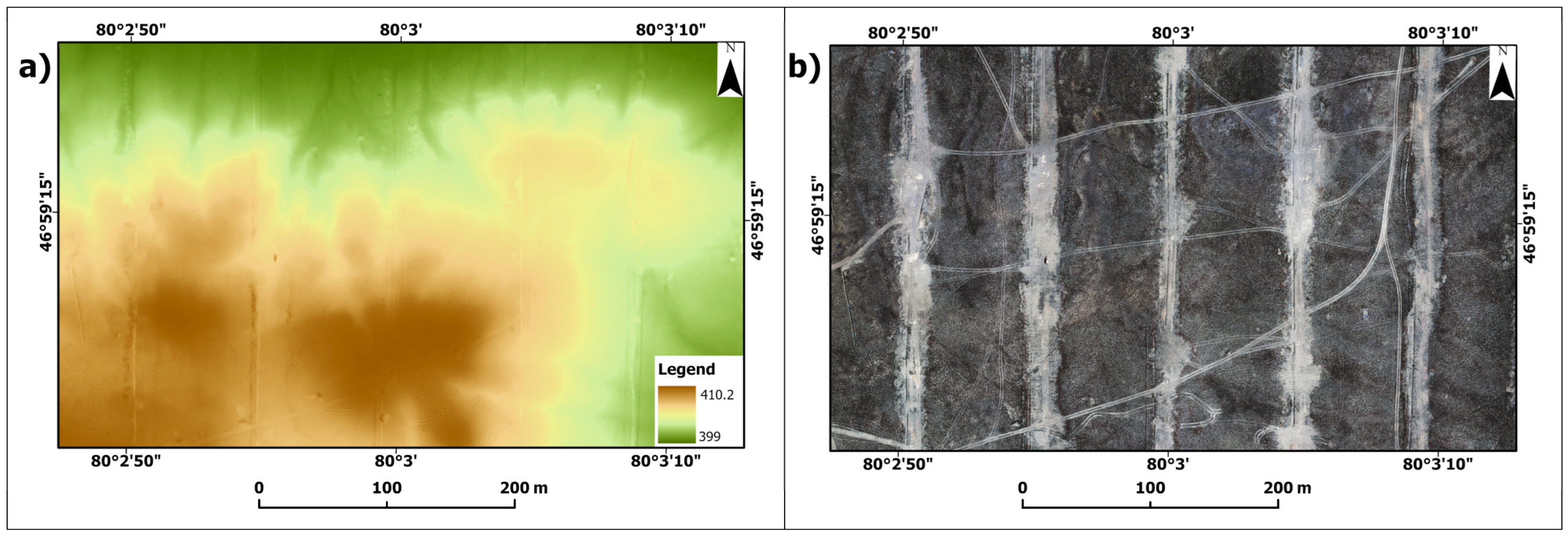


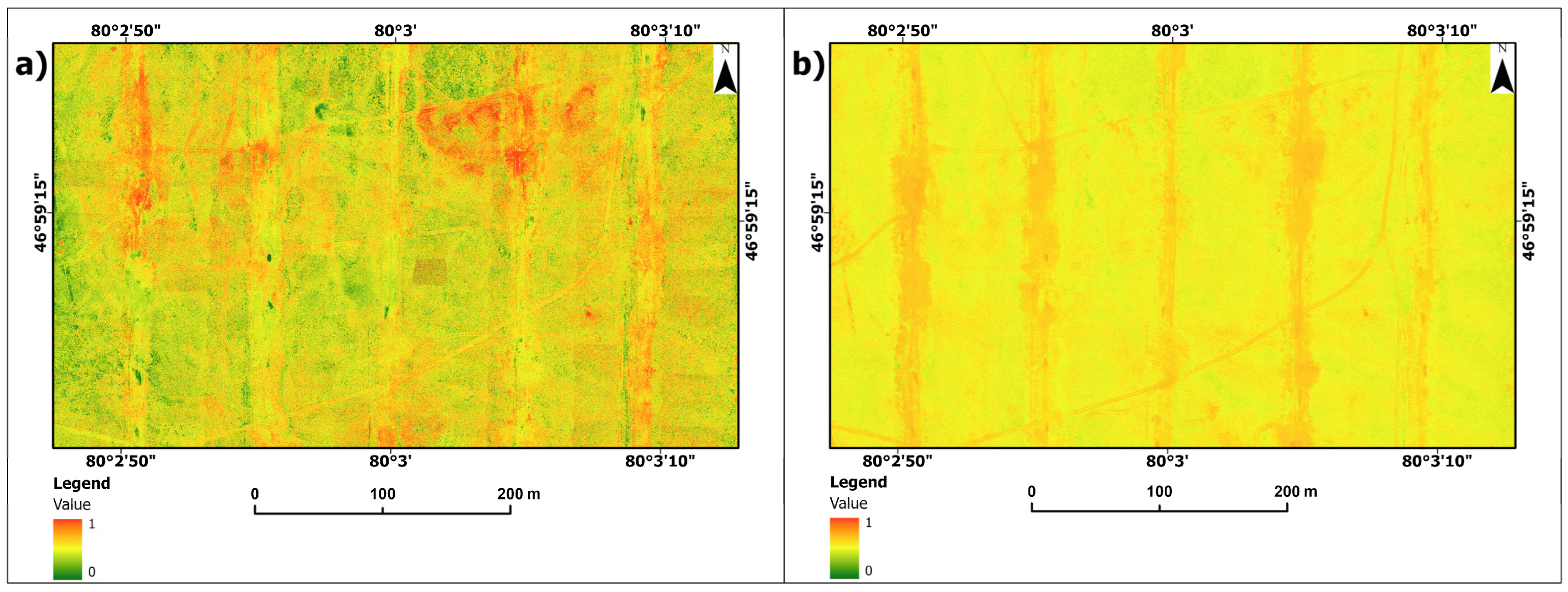
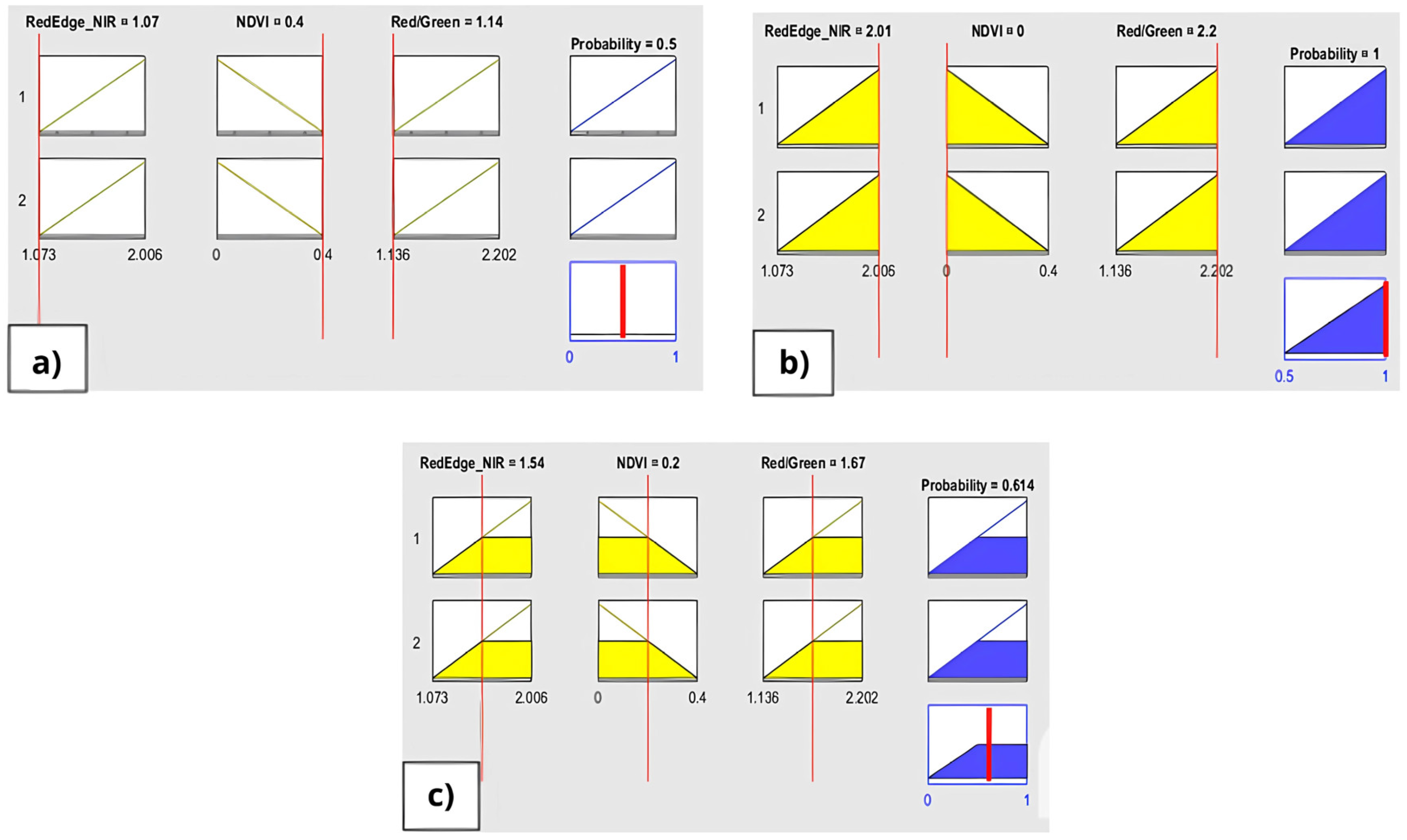

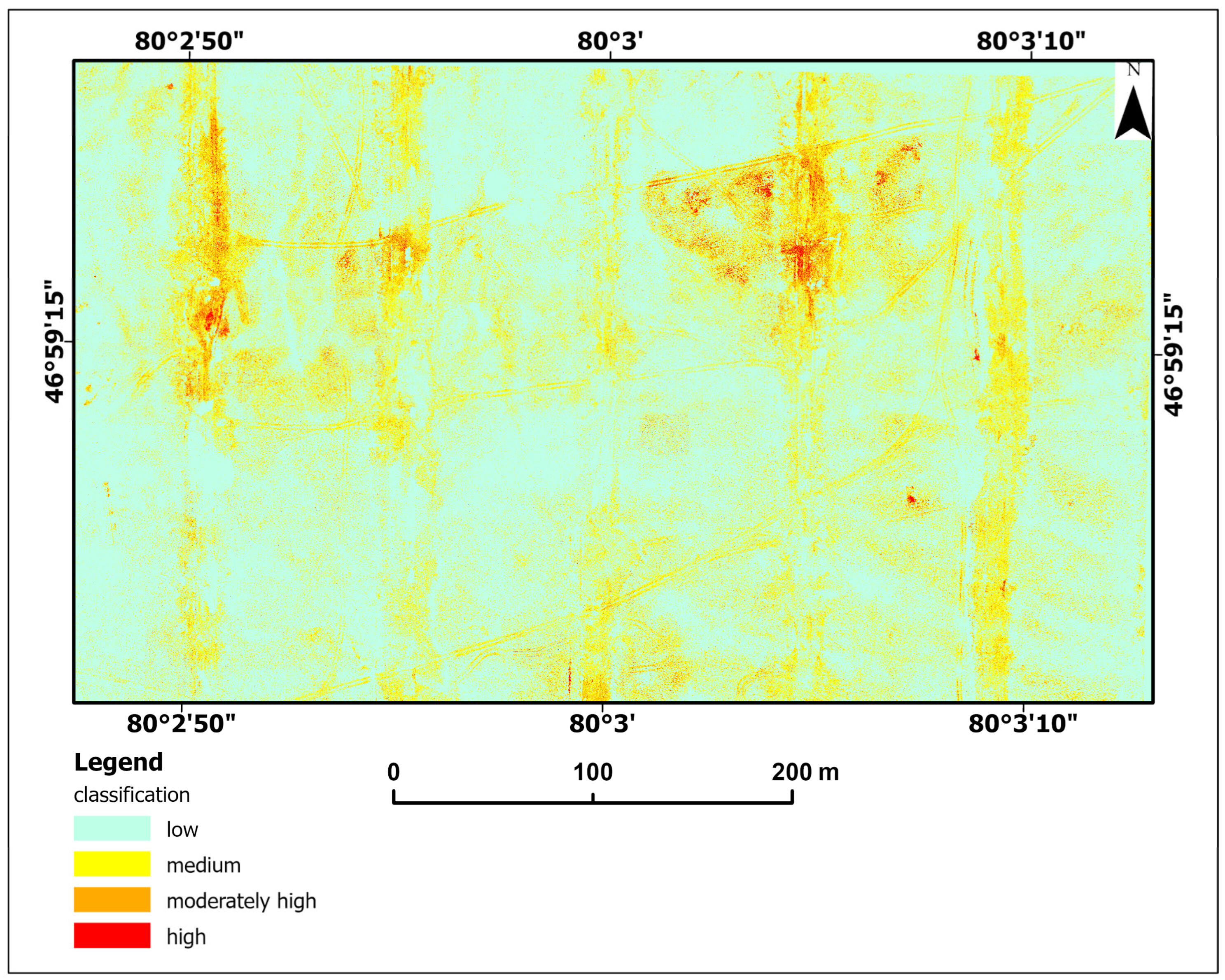
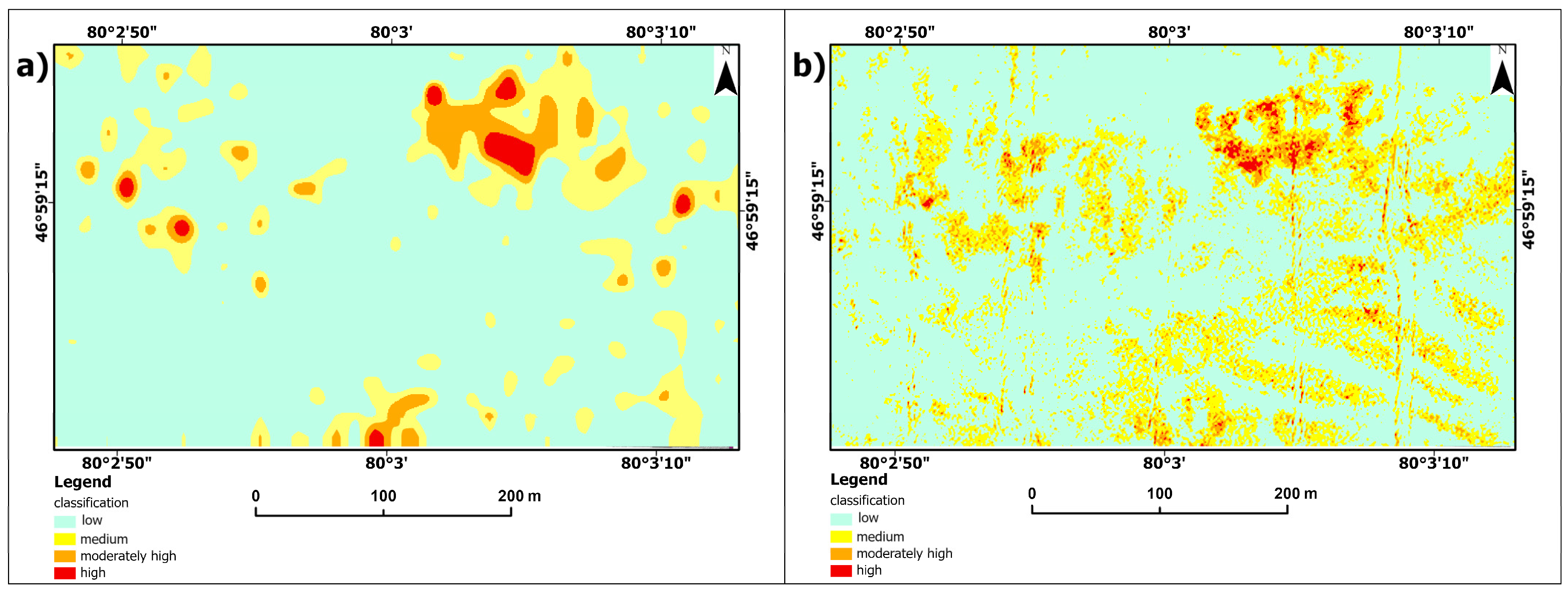
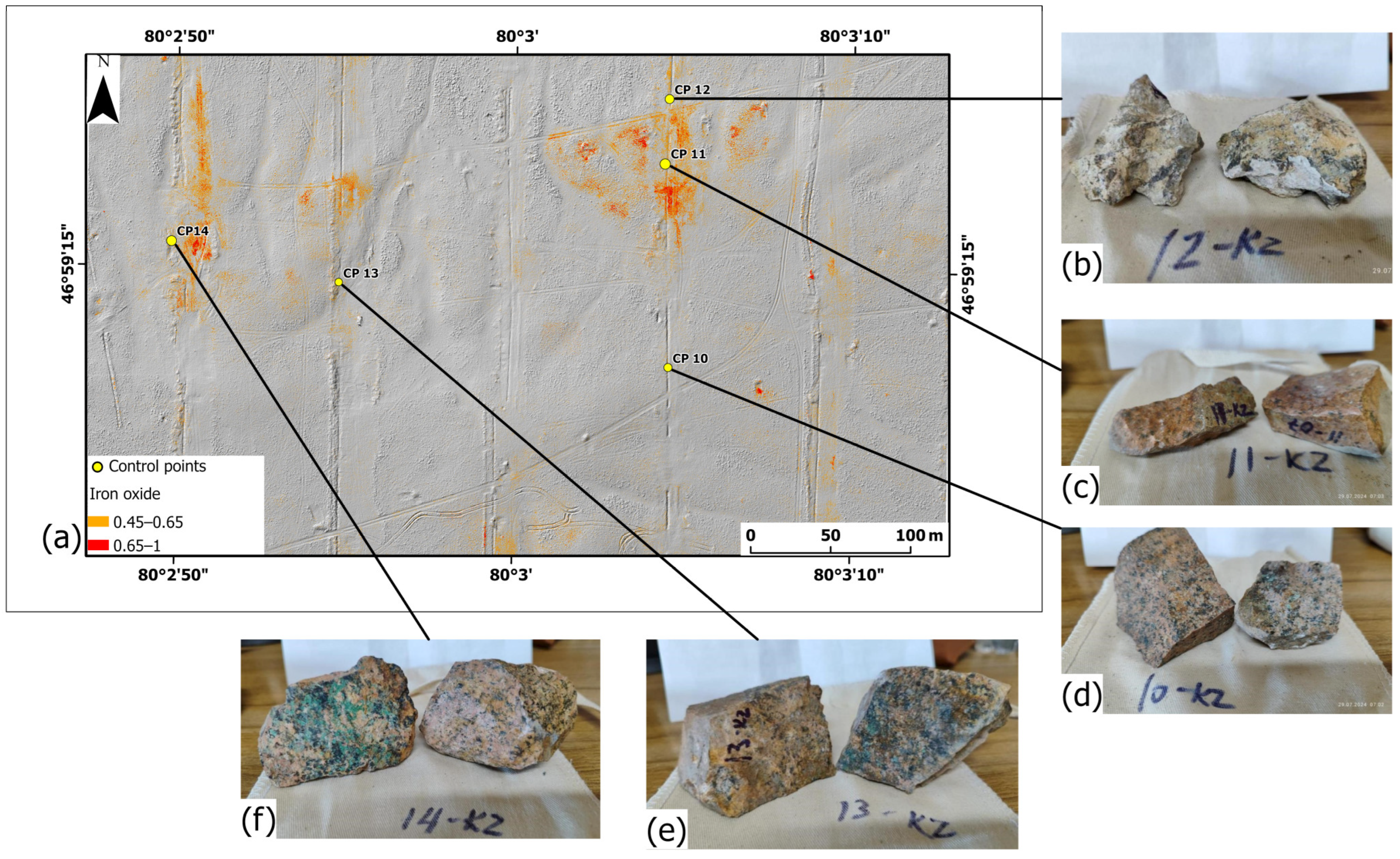
| DJI Phantom 4 Multispectral | |
|---|---|
| Parameters | Description |
| CMOS sensor resolution | 2 MΠ |
| Field of view | 62.7 |
| Flight altitude | 100 m. |
| Spatial resolution | 5.29 cm/pixel |
| Forward overlap | 70% |
| Side overlap | 60% |
| Flight duration | up to 25 min |
| Coverage area per flight | ~14 ha |
| No. of Image | Latitude | Longitude | Height | Accuracy (M) | Solution | Number of Satellites |
|---|---|---|---|---|---|---|
| DJI_0010.JPG | 46.96162854 | 79.97667615 | 467.75813 | 0.0292 | Fix | 12 |
| DJI_0011.TIF | 46.96162849 | 79.97667579 | 467.73258 | 0.0294 | Fix | 12 |
| DJI_0012.TIF | 46.96162854 | 79.97667561 | 467.7458 | 0.0294 | Fix | 12 |
| DJI_0013.TIF | 46.96162852 | 79.97667558 | 467.72792 | 0.0294 | Fix | 12 |
| DJI_0015.TIF | 46.9616284 | 79.97667592 | 467.73879 | 0.0294 | Fix | 12 |
| No | Condition | Action | Description |
|---|---|---|---|
| 1 | Low NDVI and high Band Ratio 1 and high Band Ratio 2 | High probability of mineralization | This rule indicates that if vegetation is low and both indices show high values, the probability of mineral presence is high. |
| 2 | High NDVI and one of the indices (Band Ratio_1 or Band Ratio_2) is low | Low probability of mineralization | If vegetation is dense and at least one mineralization index is low, the probability of mineral presence decreases. |
| 3 | Medium NDVI and both Band Ratio_1 and Band Ratio_2 are above the threshold | Moderate probability of mineralization | If NDVI is medium, but both indices indicate the presence of minerals, the probability will be moderate. |
| 4 | Low NDVI and one of the indices is high | High probability, assuming low vegetation | If vegetation is minimal, even one high mineralization index can indicate a high probability of mineral presence. |
| Class | Probability Percentage | Area (m2) | Percentage of Total Area (%) |
|---|---|---|---|
| Class 1 (low) | 0.0–0.25 | 133,780.92 | 73.47 |
| Class 2 (medium) | 0.25–0.45 | 38,473.55 | 21.13 |
| Class 3 (moderately high) | 0.45–0.65 | 8867.05 | 4.87 |
| Class 4 (high) | 0.65–1 | 971.03 | 0.53 |
| Class | Area (m2)—UAV | Area (m2)—WV-3 | Area (m2)—ASTER |
|---|---|---|---|
| Class 1 (low) | 133,780.92 | 134,657.28 | 141,975 |
| Class 2 (medium) | 38,473.55 | 38,175.84 | 30,150 |
| Class 3 (moderately high) | 8867.05 | 7656.48 | 8775 |
| Class 4 (high) | 971.03 | 1255.68 | 2250 |
| No. | Latitude | Longitude | Classification |
|---|---|---|---|
| CP No. 10 | 46.986959 | 80.051269 | High |
| CP No. 11 | 46.988101 | 80.051226 | High |
| CP No. 12 | 46.988466 | 80.051256 | High |
| CP No. 13 | 46.987416 | 80.048553 | High |
| CP No. 14 | 46.987637 | 80.047174 | Moderately high |
Disclaimer/Publisher’s Note: The statements, opinions and data contained in all publications are solely those of the individual author(s) and contributor(s) and not of MDPI and/or the editor(s). MDPI and/or the editor(s) disclaim responsibility for any injury to people or property resulting from any ideas, methods, instructions or products referred to in the content. |
© 2025 by the authors. Licensee MDPI, Basel, Switzerland. This article is an open access article distributed under the terms and conditions of the Creative Commons Attribution (CC BY) license (https://creativecommons.org/licenses/by/4.0/).
Share and Cite
Orynbassarova, E.; Ahmadi, H.; Adebiyet, B.; Beiranvand Pour, A.; Bekbotayeva, A.; Sydyk, N. High-Resolution UAV-Based Fuzzy Logic Mapping of Iron Oxide Alteration for Porphyry Copper Exploration: A Case Study from the Kyzylkiya Copper Prospect in Eastern Kazakhstan. Mining 2025, 5, 52. https://doi.org/10.3390/mining5030052
Orynbassarova E, Ahmadi H, Adebiyet B, Beiranvand Pour A, Bekbotayeva A, Sydyk N. High-Resolution UAV-Based Fuzzy Logic Mapping of Iron Oxide Alteration for Porphyry Copper Exploration: A Case Study from the Kyzylkiya Copper Prospect in Eastern Kazakhstan. Mining. 2025; 5(3):52. https://doi.org/10.3390/mining5030052
Chicago/Turabian StyleOrynbassarova, Elmira, Hemayatullah Ahmadi, Bakhberde Adebiyet, Amin Beiranvand Pour, Alma Bekbotayeva, and Nurmakhambet Sydyk. 2025. "High-Resolution UAV-Based Fuzzy Logic Mapping of Iron Oxide Alteration for Porphyry Copper Exploration: A Case Study from the Kyzylkiya Copper Prospect in Eastern Kazakhstan" Mining 5, no. 3: 52. https://doi.org/10.3390/mining5030052
APA StyleOrynbassarova, E., Ahmadi, H., Adebiyet, B., Beiranvand Pour, A., Bekbotayeva, A., & Sydyk, N. (2025). High-Resolution UAV-Based Fuzzy Logic Mapping of Iron Oxide Alteration for Porphyry Copper Exploration: A Case Study from the Kyzylkiya Copper Prospect in Eastern Kazakhstan. Mining, 5(3), 52. https://doi.org/10.3390/mining5030052









